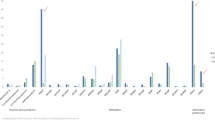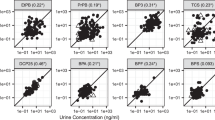Abstract
Human exposure to environmental phenols can be assessed by measuring the urinary concentrations of these compounds or their metabolites. Total concentrations, which include both free and conjugated (i.e., glucuronide and sulfated) species, are usually reported. Because conjugation may reduce the potential bioactivity of the compounds, measuring separately both the concentrations of free and conjugated species can be of interest. Data on the stability of these conjugated species in urine is critical if the concentrations of free and conjugated species are to be compared. Over a period of 6 months, we investigated the stability of the urinary conjugates of eight environmental phenols (bisphenol A, 2-hydroxy-4-metoxybenzophenone or benzophenone-3, triclosan, 2,5-dichlorophenol, methyl paraben, ethyl paraben, propyl paraben, and butyl paraben) at three storage conditions (room temperature, 4°C, and −70°C). After collection, conjugated species appeared to be stable for at least 7 days when the urine was stored at 4°C, and for at least 180 days at −70°C. By contrast, some of the environmental phenol conjugates commenced to degrade within 24 h after collection when the urine was stored at room temperature although the total concentrations remained relatively constant for at least 30 days. These results suggest that if the concentrations of free and conjugated species will be used for exposure assessment purposes, urine specimens collected for analysis of environmental phenols should be kept at room temperature for the shortest possible time after collection.
This is a preview of subscription content, access via your institution
Access options
Subscribe to this journal
Receive 6 print issues and online access
$259.00 per year
only $43.17 per issue
Buy this article
- Purchase on Springer Link
- Instant access to full article PDF
Prices may be subject to local taxes which are calculated during checkout



Similar content being viewed by others
References
Angerer J., Bird M.G., Burke T.A., Doerrer N.G., Needham L., Robison S.H., Sheldon L., and Zenick H. Strategic biomonitoring initiatives: moving the science forward. Toxicol Sci 2006: 93: 3–10.
Barr D.B., Wilder L.C., Caudill S.P., Gonzalez A.J., Needham L.L., and Pirkle J.L. Urinary creatinine concentrations in the US population: implications for urinary biologic monitoring measurements. Environ Health Perspect 2005: 113: 192–200.
Borba H., Monteiro M., Proenca M.J., Chaveca T., Pereira V., Lynce N., and Rueff J. Evaluation of some biomonitoring markers in occupationally exposed populations to acrylonitrile. Teratog Carcinog Mutag 1996: 16: 205–218.
Brondeau M.T., Hesbert A., Beausoleil C., and Schneider O. To what extent are biomonitor data available in chemical risk assessment? Hum Exp Toxicol 1999: 18: 322–326.
Calafat A.M., Kuklenyik Z., Reidy J.A., Caudill S.P., Ekong J., and Needham L.L. Urinary concentrations of bisphenol A and 4-nonylphenol in a human reference population. Environ Health Perspect 2005: 113: 391–395.
CDC. 2005 Third National Report on Human Exposure to Environmental Chemicals. Atlanta, GA, Centers for Disease Control and Prevention; National Center for Environmental Health; Division of Laboratory Sciences. Available: http://www.cdc.gov/exposurereport/3rd/pdf/thirdreport.pdf (accessed 11 August 2005).
Chen M.L., Lee WP., Chung HY., Guo B.R., and Mao I.F. Biomonitoring of alkylphenols exposure for textile and housekeeping workers. Int J Environ Anal Chem 2005: 85: 335–347.
Farmer P.B., Sepai O., Lawrence R., Autrup H., Nielsen P.S., Vestergard A.B., Waters R., Leuratti C., Jones N.J., Stone J., Baan R.A., Van-Delft J.H.M., Steenwinkel M.J.S.T., Kyrtopoulos S.A., Souliotis V.L., Theodorakopoulos N., Bacalis N.C., Natarajan A.T., Tates A.D., Haugen A., Andreassen A., Ovrebo S., Shuker D.E.G., Amaning K.S., Schouft A., Ellul A., Garner R.C., Dingley K.H., Abbondandolo A., Merlo F., Cole J., Aldrich K., Beare D., Capulas E., Rowley G., Waugh A.P.W., Povey A.C., Haque K., KirschVolders M., VanHummelen P., and Castelain P. Biomonitoring human exposure to environmental carcinogenic chemicals. Mutagenesis 1996: 11: 363–381.
Hill R.H., Head SL., Baker S., Gregg M., Shealy D.B., Bailey S.L., Williams C.C., Sampson E.J., and Needham L.L. Pesticide residues in urine of adults living in the United States: reference range concentrations. Environ Res 1995: 71: 99–108.
Hoppin J.A., Ulmer R., Calafat A.M., Barr D.B., Baker S.V., Meltzer H.M., and Ronningen K.S. Impact of urine preservation methods and duration of storage on measured levels of environmental contaminants. J Exp Sci Envirom Epidemiol 2006: 16: 39–48.
Kim Y.H., Kim C.S., Park S., Han S.Y., Pyo M.Y., and Yang M.H. Gender differences in the levels of bisphenol A metabolites in urine. Biochem Biophys Res Commun 2003: 312: 441–448.
Pirkle J.L., Needham L.L., and Sexton K. Improving exposure assessment by monitoring human tissues for toxic chemicals. J Expos Anal Environ Epidemiol 1995a: 5: 405–424.
Pirkle J.L., Sampson E.J., Needham L.L., Patterson D.G., and Ashley D.L. Using biological monitoring to assess human exposure to priority toxicants. Environ Health Perspect 1995b: 103 (Suppl 3): 45–48.
Waechter J., Domoradzki J., Thornton C., and Markham D. Factors affecting the accuracy of bisphenol a and bisphenol A-monoglucuronide estimates in mammalian tissues and urine samples. Toxicol Mech Method 2007: 17: 13–24.
WHO. 1996 Biological Monitoring of Chemical Exposure in the Workplace, Vol 1 World Health Organization, Geneva.
Ye X.Y., Bishop A.M., Needham L.L., and Calafat A.M. Parabens as urinary biomarkers of exposure in humans. Environ Health Perspect 2006a: 114: 1843–1846.
Ye X.Y., Kuklenyik Z., Bishop A.M., Needham L.L., and Calafat A.M. Quantification of the urinary concentrations of parabens in humans by on-line solid phase extraction-high performance liquid chromatography-isotope dilution tandem mass spectrometry. J Chromatogr B 2006b: 844: 53–59.
Ye X.Y., Kuklenyik Z., Needham L.L., and Calafat A.M. Automated on-line column-switching HPLC-MS/MS method with peak focusing for the determination of nine environmental phenols in urine. Anal Chem 2005a: 77: 5407–5413.
Ye X.Y., Kuklenyik Z., Needham L.L., and Calafat A.M. Quantification of urinary conjugates of bisphenol A, 2,5-dichlorophenol, and 2-hydroxy-4-methoxybenzophenone in humans by online solid phase extraction-high performance liquid chromatography-tandem mass spectrometry. Anal Bioanal Chem 2005b: 383: 638–644.
Acknowledgements
This research was supported in part by an appointment (Amber Bishop) to the Research Participation Program at the Centers for Disease Control and Prevention, National Center for Environmental Health, Division of Laboratory Sciences, administered by the Oak Ridge Institute for Science and Education through an interagency agreement between the U.S. Department of Energy and CDC. We thank Silva Manori, James L. Preau, and Ella Samandar for assistance during this research.
Author information
Authors and Affiliations
Corresponding author
Additional information
Disclaimer
The use of trade names is for identification only and does not constitute endorsement by the U.S. Department of Health and Human Services or the Centers for Disease Control and Prevention. The findings and conclusions in this report are those of the authors and do not necessarily represent the views of the Centers for Disease Control and Prevention.
Rights and permissions
About this article
Cite this article
Ye, X., Bishop, A., Reidy, J. et al. Temporal stability of the conjugated species of bisphenol A, parabens, and other environmental phenols in human urine. J Expo Sci Environ Epidemiol 17, 567–572 (2007). https://doi.org/10.1038/sj.jes.7500566
Received:
Accepted:
Published:
Issue Date:
DOI: https://doi.org/10.1038/sj.jes.7500566
Keywords
This article is cited by
-
Quantification and stability assessment of urinary phenolic and acidic biomarkers of non-persistent chemicals using the SPE-GC/MS/MS method
Analytical and Bioanalytical Chemistry (2023)
-
Comprehensive monitoring of a special mixture of prominent endocrine disrupting chemicals in human urine using a carefully adjusted hydrolysis of conjugates
Analytical and Bioanalytical Chemistry (2023)
-
Improved method for the determination of endocrine-disrupting chemicals in urine of school-age children using microliquid–liquid extraction and UHPLC-MS/MS
Analytical and Bioanalytical Chemistry (2022)
-
Exposure to environmental phenols and parabens, and relation to body mass index, eczema and respiratory outcomes in the Norwegian RHINESSA study
Environmental Health (2021)
-
Gene X environment: the cellular environment governs the transcriptional response to environmental chemicals
Human Genomics (2020)



